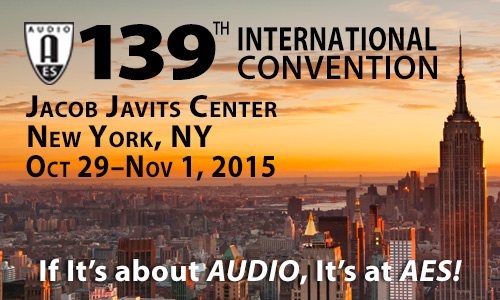AES New York 2015
Paper Session P16
Saturday, October 31, 2:15 pm — 3:45 pm (Room 1A07)
Paper Session: P16 - Room Acoustics
Chair:
Rémi Audfray, Dolby Laboratories, Inc. - San Francisco, CA, USA
P16-1 Environments for Evaluation: The Development of Two New Rooms for Subjective Evaluation—Elisabeth McMullin, Samsung Research America - Valencia, CA USA; Adrian Celestinos, Samsung Research America - Valencia, CA, USA; Allan Devantier, Samsung Research America - Valencia, CA, USA
An overview of the optimization, features, and design of two new critical listening rooms developed for subjective evaluation of a wide-array of audio products. Features include a rotating wall for comparing flat-panel televisions, an all-digital audio switching system, custom tablet-based testing software for running a variety of listening experiments, and modular acoustic paneling for customizing room acoustics. Using simulations and acoustic measurements, a study of each of the rooms was performed to analyze the acoustics and optimize the listening environment for different listening situations.
Convention Paper 9460 (Purchase now)
P16-2 Low Frequency Behavior of Small Rooms—Renato Cipriano, Walters Storyk Design Group - Belo Horizonte, Brazil; Robi Hersberger, Walters Storyk Design Group - New York, USA; Gabriel Hauser, Walters Storyk Design Group - Basel, Switzerland; Dirk Noy, WSDG - Basel, Switzerland; John Storyk, Architect, Studio Designer and Principal, Walters-Storyk Design Group - Highland, NY, USA
Modeling of sound reinforcement systems and room acoustics in large- and medium-size venues has become a standard in the audio industry. However, acoustic modeling of small rooms has not yet evolved into a widely accepted concept, mainly because of the unavailable tool set. This work introduces a practical and accurate software-based approach for simulating the acoustic properties of studio rooms based on BEM. A detailed case study is presented and modeling results are compared with measurements. It is shown that results match within given uncertainties. Also, it is indicated how the simulation software can be enhanced to optimize loudspeaker locations, room geometry, and place absorbers in order to improve the acoustic quality of the space and thus the listening experience.
Convention Paper 9461 (Purchase now)
P16-3 Measuring Sound Field Diffusion: SFDC—Alejandro Bidondo, Universidad Nacional de Tres de Febrero - UNTREF - Caseros, Buenos Aires, Argentina; Mariano Arouxet, Universidad Nacional de Tres de Febrero - Buenos Aires, Argentina; Sergio Vazquez, Universidad Nacional de Tres de Febrero - Buenos Aires, Argentina; Javier Vazquez, Universidad Nacional de Tres de Febrero - Buenos Aires, Argentina; Germán Heinze, Universidad Nacional de Tres de Febrero - Buenos Aires, Argentina
This research addresses the usefulness of an absolute descriptor to quantify the degree of diffusion in a third octave band basis of a sound field. The degree of sound field diffuseness in one point is related with the reflection’s energy control multiplied by the temporal distribution uniformity of reflections. All this information is extracted from a monaural, broadband, omnidirectional, high S/N impulse response. The coefficient range varies between 0 and 1, evaluates the early, late, and total sound field for frequencies above Schroeder’s and in the far field from diffusive surfaces, zero being “no diffuseness” at all. This coefficient allows the comparison of different rooms, different places inside rooms, measurement of the effects of different sound diffusers coatings, and the resulting spatial uniformity variation, among other applications.
Convention Paper 9462 (Purchase now)

